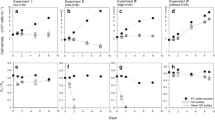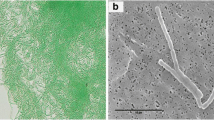Abstract
Photosynthesis by cells of Prochloron sp. freshly isolated from the ascidian host, Lissoclinum patella, collected from shallow waters in Palau, was severely inhibited by ultraviolet (UV) irradiation. No photoinhibition, however, was observed in Prochloron cells isolated from intact colonies after UV irradiation, suggesting some protection by the ascidian host. It was shown that UV protection was brought about by the thick gelatinous tunic covering the whole ascidian colony. Analysis revealed that the surface tunic of L. patella, although transparent to visible light, contains several UV-absorbing substances, identified by high-performance liquid chromatography as mycosporine-like amino acids (MAAs). The predominant MAA identified was shinorine (λmax = 334 nm), followed by mycosporine-glycine (λmax = 310 nm) and a small amount of palythine (λmax = 320 nm). Although isolated Prochloron cells also contained shinorine, on a protein-weight basis it was less than half of that observed in the host tunic. These results suggest that the surface tunic of a L. patella colony, which is transparent to visible light for photosynthesis, also contains UV-absorbing compounds that protect its photoautotrophic symbiont, Prochloron sp., from damage by the intense UV-irradiation that they receive daily in shallow, tropical marine waters.
Similar content being viewed by others
Author information
Authors and Affiliations
Additional information
Received: 15 December 1996 / Accepted: 28 January 1997
Rights and permissions
About this article
Cite this article
Dionisio-Sese, M., Ishikura, M., Maruyama, T. et al. UV-absorbing substances in the tunic of a colonial ascidian protect its symbiont, Prochloron sp., from damage by UV-B radiation. Marine Biology 128, 455–461 (1997). https://doi.org/10.1007/s002270050112
Issue Date:
DOI: https://doi.org/10.1007/s002270050112




